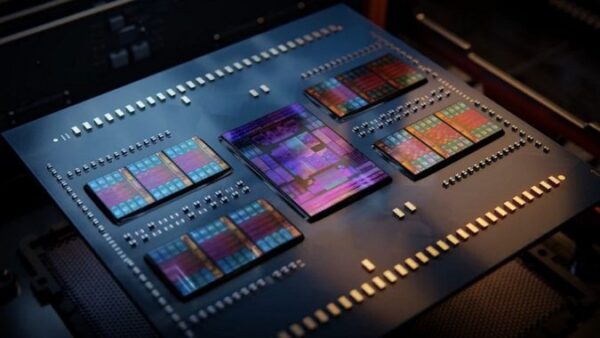What is a Chiplet?

More from the Category
The world of microelectronics is undergoing a revolution, fueled by a demand for faster, smaller, and more powerful devices. In this dynamic landscape, a groundbreaking concept known as chiplets is emerging as a transformative force—one with the potential to reshape the future of computing.
At the heart of the chiplet revolution lies the idea of dismantling traditional monolithic semiconductor chips into smaller, specialized modules that can be manufactured and assembled independently. By interconnecting these chiplets on a single package, designers can mix and match functionalities, allowing for enhanced customization, cost-effectiveness, and improved performance across a wide range of applications.
With chiplets paving the way for innovative computing architectures, the possibilities for even greater leaps in processing power and energy efficiency seem boundless—ushering in a new era of advancement and pushing the boundaries of what’s currently possible.
Defining Chiplets
A chiplet is a semiconductor component, meticulously designed to perform a specific function within an integrated circuit (IC) system. Unlike traditional monolithic ICs—where all components are integrated onto a single silicon die—chiplets break complex systems into smaller, function-specific building blocks.
By optimizing individual chiplets for tasks like logic processing, memory, I/O, or communication, designers can achieve higher efficiency, better scalability, and lower power consumption. This modular approach allows teams to reuse proven chiplets across multiple designs, reducing development time and cost.
Additionally, manufacturers benefit from improved yields, since smaller chiplets are less prone to defects than large monolithic dies. The result is a flexible, high-performance alternative to conventional IC design.
However, for chiplets to function effectively, standardized interfaces and interconnects are critical. That’s where efforts like UCIe (Universal Chiplet Interconnect Express) come in—providing open industry standards for communication between chiplets, regardless of vendor. These standards are helping to create a more interoperable and scalable ecosystem.
As the technology continues to evolve, chiplets are poised to revolutionize industries from high-performance computing and AI to consumer electronics and 5G infrastructure.
The Power of Chiplets

The power of chiplet technology lies in its ability to divide a complex system into smaller, purpose-built modules. Each chiplet is engineered to excel at a specific task—whether it’s logic computation, memory access, signal processing, or connectivity.
These chiplets are integrated into a single system using a silicon interposer, which acts as an advanced substrate. Interposers enable high-speed communication, efficient power distribution, and cohesive system performance.
Interposers handle electrical connectivity and help manage thermal dissipation, spreading heat across the package and improving reliability. The result is a compact, high-performance package known as a System-on-Package (SoP) or System-in-Package (SiP).
This flexible architecture allows engineers to innovate faster. Rather than being constrained by a one-size-fits-all chip design, they can select the best chiplets for their needs—paving the way for truly optimized systems.
How Chiplets Work
To fully appreciate chiplet technology, it’s important to understand the underlying mechanisms that make it work. The chiplet ecosystem is driven by advanced packaging technologies, particularly silicon interposers.
These interposers act as bridges between chiplets, facilitating high-bandwidth data transfer and efficient power delivery. Their sophisticated wiring and signaling capabilities allow chiplets to work together as seamlessly as if they were part of a single monolithic die.
One major advantage of interposers is that they allow chiplets to be manufactured using different process technologies—for example, a 5nm chiplet for logic and a 16nm chiplet for I/O—without compromising system compatibility.
As interposer technology advances, we’re seeing improved data rates, lower latency, and higher energy efficiency. This means chiplet-based systems can meet the demands of cutting-edge applications, from AI to data centers to industrial automation.
Collaboration across the industry is also growing. Major players like AMD, Intel, and TSMC are investing heavily in chiplet ecosystems, driving faster adoption and unlocking innovation at scale.
Advantages of Chiplet Technology
Chiplet-based design introduces numerous benefits that are reshaping how semiconductors are built:
Design Flexibility: Designers can mix and match the best-performing chiplets for specific functions. This customization leads to highly efficient and optimized systems, tailored for unique use cases.
Faster Time-to-Market: Because chiplets are developed independently, engineers can work on different modules in parallel. This shortens design cycles and speeds up product releases.
Improved Performance and Yield: Manufacturing smaller chiplets separately allows for better process optimization. This often results in higher yields and superior overall system performance.
Cost Efficiency: Large monolithic chips are expensive and can suffer from yield issues. Chiplets offer a cost-effective alternative by reducing silicon waste and enabling reusability across designs.
Future Applications and Impact
The potential applications of chiplet technology are vast and already taking root in key industries:
High-Performance Computing: Chiplets enable the construction of ultra-scalable processors for supercomputers and hyperscale data centers. AMD’s EPYC processors and Intel’s Meteor Lake architecture are prominent examples.
Consumer Electronics: Smartphones, tablets, and wearables are benefitting from more power-efficient chiplet designs, delivering better performance without compromising battery life.
Artificial Intelligence & Machine Learning: The modularity of chiplets allows for the development of custom AI accelerators, with each chiplet optimized for specific neural network functions.
5G and Future Connectivity: As bandwidth demands grow, chiplets make it easier to develop specialized communication chips with ultra-low latency and high throughput.
Edge & IoT Devices: Miniaturized chiplet-based systems allow for smarter, smaller, and more connected devices—including in industrial automation and healthcare.
Looking Ahead
Let Microchip USA Help You Build the Future
As the demand for next-generation microelectronics continues to grow, traditional monolithic ICs are beginning to show their limits. Chiplet technology offers a smarter, more scalable path forward—one that promises shorter time-to-market, lower costs, and greater design freedom.
At Microchip USA, we understand the challenges of navigating new technologies. That’s why our team of IC and Semiconductor Sourcing Specialists is here to help you source the right components, explore alternatives, and bring your modular system designs to life.
Whether you're designing for AI, 5G, medical devices, or consumer tech—chiplets offer the flexibility to future-proof your innovations. And we’re here to support you at every step.
Need help sourcing chiplets or other advanced semiconductors? Contact us today!